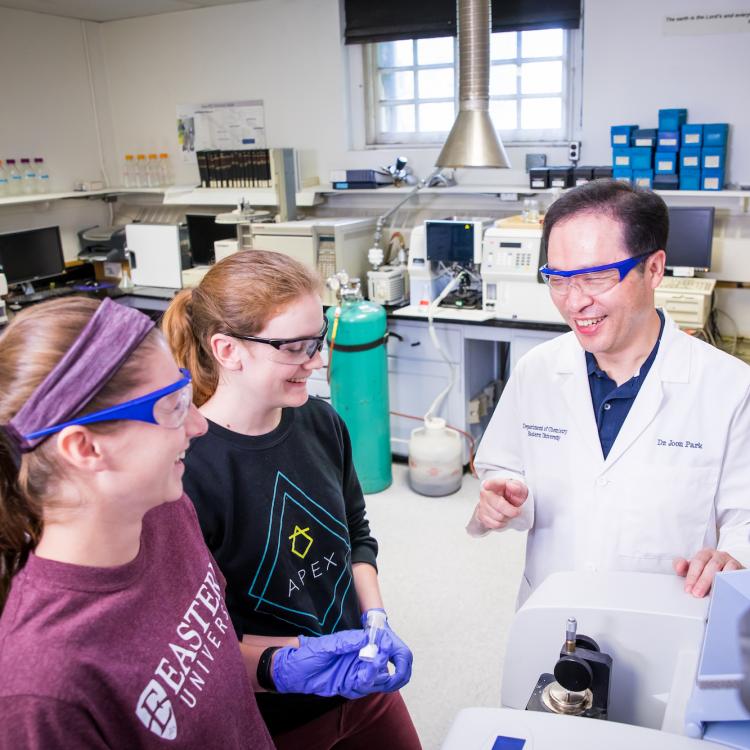
Research Areas
Fire blight is a devastating plant disease that occurs in apple and pear trees, as well as other members of the family Rosaceae. The cause of this disease is a bacterium called Erwinia amylovora, which is related to common human pathogens including E. coli, various Salmonella species, and Yersinia pestis, the cause of plague. Fire blight bacteria infect and destroy the blossoms, the immature fruit, and even the foliage of fruit trees, leaving a blackened, scorched appearance in their wake. Epidemics can wipe out an entire orchard. In some regions, fire blight disease is such a severe problem that apple and pear trees are difficult to grow commercially. Fire blight also exists within Pennsylvania.
During the establishment of an infection, the fire blight pathogen unleashes an arsenal of chemical weapons, virulence factors, aimed at defeating plant defenses. Several of these virulence factors are toxic proteins that are directly injected into the plant cells at the site of infection via a type III secretion system. Others may possibly take the form of chemical toxins that are synthesized and secreted in order to cause injury to the plant. Improved strategies to combat fire blight will ultimately emerge from a better understanding of molecular mechanisms by which bacterial virulence factors act against the host.
Genome sequencing studies at Cornell University have identified a ~62 kilobase region within the bacterial chromosome where a number of genes required for pathogenicity are located. Not surprisingly, many of the genes in this region exhibit sequence similarity to known or suspected virulence factors in other pathogens. One locus of particular interest and significance contains a series of five genes, hsvA, hsvB, hsvC, orf12, and orf13, organized into two operons, which are predicted to encode proteins having enzymatic function. The requirement for at least three of these genes to be present for full virulence in apple suggests that they function as part of a pathway, perhaps synthesizing a small molecule toxin or hormone that affects plant metabolism.
Although the putative functions of these five genes have been predicted from sequence analysis, the biochemical activities of the proteins they encode remain largely uncharacterized. In order to investigate the biochemical activity of these proteins, and to gain insight into their roles in pathogenicity, we are working to clone these five genes into a suitable heterologous prokaryotic expression system to produce recombinant protein, developing appropriate purification strategies, and characterizing the biochemical functions of these five proteins. We are investigating the enzymatic activity and substrate specificity using various in vitro substrate binding and enzymatic activity assays that have been applied successfully in other systems. Ultimately, for those proteins that are amenable to crystallization, we intend to use X-ray crystallography to determine the atomic structures in order to gain further insight into the roles of these proteins in pathogenesis.
The results of these studies are expected to provide important insights into the enzymatic capabilities of these five proteins and will lead to testable hypotheses about the in vivo substrates that may be used and the potential products that may arise during infection, ultimately shedding light upon the role of these proteins as virulence factors in E. amylovora and suggesting novel strategies for combating fire blight disease. The results of this investigation will also provide further insight into the dynamics of host-pathogen interactions in general, especially with regard to pathogen strategies that involve the production of toxins, antimetabolites, or hormones aimed at subverting host defenses.
Abstracts Presented at Local Undergraduate Research Symposia
Kreiter C and Sieber N, Selg A, and Lawton JA. “Cloning, Expression, and Biochemical Characterization of HsvB, a Virulence Factor from the Fire Blight Pathogen.” 21st Annual Saint Joseph’s University Sigma Xi Student Research Symposium, St. Joseph’s University, Philadelphia, PA, 23 April 2010. Poster Presentation
Metzler D and Lawton JA. “Expression, purification, and biochemical characterization of HsvA, a protein required for full virulence in the plant pathogen, Erwinia amylovora.” 19th Annual Saint Joseph’s University Sigma Xi Student Research Symposium, St. Joseph’s University, Philadelphia, PA, 18 April 2008. Poster presentation.
Rhys J, Brett J, and Lawton JA. “Cloning and expression of OrfC and DspF, molecular chaperones in Erwinia amylovora.” 19th Annual Saint Joseph’s University Sigma Xi Student Research Symposium, St. Josephs’s University, Philadelphia, PA, 18 April 2008. Poster presentation.
Mensch C, Fichera M, and Lawton JA. “Heterologous Expression and Functional Characterization of Secretion and Nuclear Localization Signals in OrfM, a Potential Virulence-Associated Protein from the Plant Pathogen Erwinia amylovora.” 18th Annual Saint Joseph’s University Sigma Xi Student Research Symposium, St. Joseph’s University, Philadelphia, PA, 20 April 2007. Poster presentation.
Abler E and Lawton JA. “Cloning and expression of virulence-associated protein Orf13 from Erwinia amylovora.” 17th Annual Saint Joseph’s University Sigma Xi Student Research Symposium, St. Joseph’s University, Philadelphia, PA, 22 April 2006. Poster presentation.
Glendinning E and Lawton JA. “Heterologous expression of OrfA from Erwinia amylovora for protein characterization.” 17th Annual Saint Joseph’s University Sigma Xi Student Research Symposium, St. Joseph’s University, Philadelphia, PA, 22 April 2006. Poster presentation.
Jung E and Lawton JA. “Cloning and expression of Orf12, a virulence-associated protein from Erwinia amylovora.” 17th Annual Saint Joseph’s University Sigma Xi Student Research Symposium, St. Joseph’s University, Philadelphia, PA, 22 April 2006. Poster presentation.
Research Publications
McMahon SA and Miller JL, Lawton JA, Kerkow DE, Hodes A, Marti-Renom MA, Doulatov S, Narayanan E, Sali A, Miller JF, and Ghosh P. (2005). “The C-type lectin fold as an evolutionary solution for massive sequence variation.” Nature Structural and Molecular Biology 12, 886-892.
Que X, Ngo H, Lawton J, Gray M, Liu Q, Engel J, Brinen L, Ghosh P, Joiner KA, and Reed SL. (2002). “The Cathepsin B of Toxoplasma gondii, Toxopain-1, is critical for parasite invasion and rhoptry protein processing.” J. Biol. Chem. 277, 25791-25797.
Feng N*, Lawton JA*, Greenberg HB, and Prasad BVV. (2002). “Inhibition of rotavirus replication by a non-neutralizing, rotavirus VP6-specific IgA mAb.” J. Clin. Invest. 109, 1203-1213. (* contributed equally to the work)
Crawford SE, Mukherjee SK, Estes MK, Lawton JA, Shaw AL, Ramig RF, and Prasad BVV. (2001). “Trypsin cleavage stabilizes the rotavirus VP4 spike.” J. Virol. 75, 6052-6061.
Pesavento J, Lawton JA, Estes MK, and Prasad BVV. (2001). “The reversible condensation and expansion of the rotavirus genome.” Proc. Natl. Acad. Sci. USA 98, 1381-1386.
Lawton JA, Estes MK, and Prasad BVV. (2001). “Identification and characterization of a transcription pause site in rotavirus.” J. Virol., 75, 1632-1642.
Lawton JA, Estes MK, and Prasad BVV. (1999). "Comparative structural analysis of transcriptionally competent and incompetent rotavirus-antibody complexes." Proc. Natl. Acad. Sci. USA 96, 5428-5433.
Lawton JA, Zeng CQ-Y, Mukherjee SK, Cohen J, Estes MK, and Prasad BVV. (1997). Three-dimensional structural analysis of recombinant rotavirus-like particles with intact and amino-terminal deleted VP2: Implications for the architecture of the VP2 capsid layer." J. Virol. 71, 7353-7360.
Lawton JA, Estes MK, and Prasad BVV. (1997). "Three dimensional visualization of mRNA release from actively transcribing rotavirus particles." Nature Struct. Biol. 4, 118-121.
Prasad BVV, Rothnagel R, Zeng CQ-Y, Jakana J, Lawton JA, Chiu W, and Estes MK. (1996). "Visualization of ordered genomic RNA and localization of transcriptional complexes in rotavirus." Nature 382, 471-473.
Lawton JA and Prasad BVV. (1996). "Automated software package for icosahedral virus reconstruction." J. Struct. Biol. 116, 209-215.
Leonowicz ME, Lawton JA, Lawton SL, and Rubin MK. (1994). "MCM-22: A molecular sieve with two independent multidimensional channel systems." Science 264, 1910-1913.
Invited Reviews
Lawton JA and Ghosh P. (2003). “Novel therapeutic strategies based on toll-like receptor signaling.” Curr. Opin. Chem. Biol. 7, 446-451.
Prasad BVV, Crawford S, Lawton JA, Pesavento J, Hardy M, and Estes MK. (2001). “Structural studies on gastroenteritis viruses.” Novartis Found Symp. 238, 26-37.
Lawton JA, Estes MK, and Prasad BVV. (2000). “Mechanism of genome transcription in segmented dsRNA viruses.” Adv. Virus Res. 55, 185-230.
Shaw AL, Rothnagel R, Zeng CQ-Y, Lawton JA, Ramig RF, Estes MK, and Prasad BVV. (1996). "Rotavirus structure: Interactions between the structural proteins." Archives of Virology 12, 21-27 [suppl.]
Lawton JA, Lawton SL, Leonowicz ME, and Rubin MK. (1995). "The framework topology of zeolite MCM-22." Studies in Surface Science and Catalysis (Zeolite Science 1994: Recent Progress and Discussions). Karge HG and Weitkamp J. eds., Vol. 98, pp. 250-251
My research interests are focused on the engineering of bio-inspired molecules and molecular assemblies using organic chemistry. Biological phenomena, concepts, and structures have recently provided material scientists with great inspiration for the development of novel materials having attractive structures and properties. Organic chemistry has played a critical role in the development of bio-inspired materials and the resulting materials have been widely used in a variety of practical applications such as biological sensing and biomedical diagnostics. I will develop strategies to prepare novel bio-inspired organic materials and seek their applications in bionanotechnology. Below I briefly introduce three representative examples of research projects that I pursue:
1) Liquid Crystal-Based Screening of Kinase Activity
Detection of biomolecules is a critical step in a variety of practical biotechnologies including biomedical diagnostics and biological sensing. To develop surface-based biosensors, the biochemical event occurring at an interface should be converted into a measurable output signal to be detected. Past studies showed that liquid crystals can be effectively used as a signal transducer to amplify and report chemical and biochemical events on a surface. I will develop a novel strategy to incorporate peptide substrates into an aqueous-liquid crystal interface. The peptide-modified aqueous-liquid crystal interface will be used to visualize kinase activities.
2) Multifunctional Dendrimer-Based Nanodevice for Diagnostic Imaging
Dendrimers are highly branched, highly functionalized polymers with a well-defined symmetrical structure. Poly(amidoamine) (PAMAM) dendrimers consisting of beta-alanine subunits are often called as "artificial proteins" due to their similarities in sizes, shapes, and structures. I will develop a novel method to prepare a covalently conjugated dendrimer-nanoparticle nanocomposite which can be used for targeted diagnostic magnetic resonanace imaging (MRI). The method consists of the functionalization of PAMAM dendrimers and the subsequent covalent conjugation with nanoparticles prepared in a separate step.
3) Nanoparticle-Based Detection of Proteases
Nanometer-scale metal particles have been enjoying a great deal of interest from researchers due to their potential applications in electronics, catalysis, molecular recognition, and chemical and biological sensing. The size-dependent electronic, magnetic, and optical properties of metal nanoparticles (quantum size effect) have been utilized in the field of biomolecular diagnostics and detections. I will develop a simple assay system for proteases using gold nanoparticles immobilized at peptide-modified interfaces. To prepare the system, peptide substrates that can be hydrolyzed by a protease will be immobilized to polymer or metal surface. Subsequently, gold nanoparticles will be conjugated to the immobilized peptide substrates. A merit of this approach is that the presence of a protease can be visually monitored with bare eyes.
Research Publications
"Analysis of the Wettability of Partially Fluorinated Polymers Reveals the Surprisingly Strong Polar or Acid-Base? Character of Poly(vinylidene Fluoride)", Sangwha Lee; Joon-Seo Park; T. Randall Lee, Chemical Engineering Journal, Manuscript in preparation.
"A Sensing Device Using Liquid Crystal in a Micropillar Array Supporting Structure", Daming Cheng; Sudheer S. Sridharamurthy; Jacob T. Hunter; Joon-Seo Park; Nicholas L. Abbott; Hongrui Jiang, Journal of Microelectromechanical Systems, 2009, 18, 973-982.
"Ordering Transitions in Thermotropic Liquid Crystals Induced by the Interfacial Assembly and Enzymatic Processing of Oligopeptide-Amphiphiles", Joon-SeoPark; Nicholas L. Abbott, Advanced Materials, 2008, 20, 1185-1190.
"Preparation, Characterization, and Chemical Stability of Gold Nanoparticles Coated with Mono-, Bis-, and Tris-Chelating Alkanethiols", La-ongnuanSrisombat; Joon-SeoPark; Shishan Zhang; T. Randall Lee, Langmuir, 2008, 24, 7750-7754.
"The Wettability of Fluoropolymer Surfaces: Influence of Surface Dipoles", Sangwha Lee; Joon-SeoPark; T. Randall Lee, Langmuir, 2008, 24, 4817-4826.
"Coupling of the Plasmon Resonance of Chemically Functionalized Gold Nanoparticles to Local Order in Thermotropic Liquid Crystals", Gary M. Koenig, Jr.; Maria-Victoria Meli; Joon-Seo Park; Juan J. de Pablo; Nicholas L. Abbott, Chemistry of Materials 2007, 19, 1053-1061.
"Formation of Oligopeptide-Based Polymeric Membranes at Interfaces Between Aqueous Phases and Thermotropic Liquid Crystals", Joon-Seo Park; Sarah Teren; William H. Tepp; David J. Beebe; Eric A. Johnson; Nicholas L. Abbott, Chemistry of Materials 2006, 18, 6147-6151.
"Influence of 4-Cyano-4’-biphenylcarboxylic Acid on the Orientational Behavior of Cyanobiphenyl Liquid Crystal", Joon-Seo Park; Chang-Hyun Jang; Matthew L. Tingey; Aaron M. Lowe; Nicholas L. Abbott, Journal of Colloid and Interface Science 2006, 304, 459-473.
"Synthesis of Tetraoctylammonium-Protected Gold Nanoparticles with Improved Stability", Steven R. Isaacs; Erin C. Cutler; Joon-Seo Park; T. Randall Lee; Young-Seok Shon, Langmuir 2005, 21, 5689-5692.
"Systematic Control of the Packing Density of Alkyl Chains in Self-Assembled Monolayers on Gold Generated from Chelating Alkanethiols", Joon-Seo Park; Andy Nguyen Vo; David Barriet; Young-Seok Shon; T. Randall Lee, Langmuir 2005, 21, 2902-2911.
"Synthesis and Ring-Opening Metathesis Polymerization (ROMP) of Aryl-Substituted 1,1’-(1,3-Butadienylene)ferrocenes", Richard W. Heo; Joon-SeoPark; T. Randall Lee, Macromolecules 2005, 38, 2564-2573.
"ROMP of t-Butyl-Substituted Ferrocenophanes Affords Soluble Conjugated Polymers that Contain Ferrocene Moieties in the Backbone", Richard W. Heo; Joon-Seo Park; Jason T. Goodson; Gil C. Claudio; Mitsuru Takenaga; Thomas A. Albright; T. Randall Lee, Tetrahedron 2004, 60, 7225-7235.
"Loosely Packed Self-Assembled Monolayers on Gold Generated from 2-Alkyl-2-methylpropane-1,3-dithiols", Joon-SeoPark; Aaron C. Smith; T. Randall Lee, Langmuir 2004, 20, 5829-5836.
"Stability of Aliphatic Dithiocarboxylic Acid Self-Assembled Monolayers on Gold", Tai-Chou Lee; Donna J. Hounihan; Ramon Colorado, Jr.; Joon-Seo Park; T. Randall Lee, Journal of Physical Chemistry B 2004, 108, 2648-2653.
"Carbon-Bridged Ferrocenophanes", Joon-SeoPark; T. Randall Lee, In Modern Cyclophane Chemistry, Henning Hopf and Rolf Gleiter Eds.; Wiley: Weinheim, 2004; pp 131-157.
"Synthesis, Characterization, and Reactivity of ReOMe2(bipy)X Complexes", June-Ho Jung; Joon-SeoPark; David M. Hoffman; T. Randall Lee, Polyhedron 2001, 20, 2129-2136.
"Determination of Stability Constants Using Electrochemical Methods for Complex Formation of Platinum and Palladium with Polyelectrolytes", Joon Seo Park; Koo Soon Chung, Analytical Science & Technology 1995, 8, 691-698.
Patents
"Device and Methods for Liquid Crystal-Based Bioagent Detection", N. L. Abbott, J.-S. Park, S. Teren, D. J. Beebe, E. A. Johnson, US2007231832 (U.S.A.), WO2007111681 (PCT).
"Cholesterol Biosynthesis Inhibitors", J. H. Kim, T. N. Jhong, Y. K. Paik, J. S. Park, E. D. Kim, Y. S. Lee, S. U. Kim, US6255317 (U.S.A.).
"13, 13α-Didehydroberberine Derivatives", J. H. Kim, T. N. Jhong, Y. K. Paik, J. S. Park, E. D. Kim, Y. S. Lee, S. U. Kim, US6239139 (U.S.A.).
"Aryl Benzoyl Urea Derivative and Pesticidal Composition Comprising the Same", J. H. Kim, J. W. Woo, Y. W. Shin, J. N. Heo, E. D. Kim, J. S. Park, US6051737 (U.S.A.), WO9724321 (PCT), JP11501332 (Japan), EP939753 (Europe), CN1205686 (China), IN185380 (India), BR9612312 (Brazil), KR1001945350000 (Korea, Patent Number).
"Pharmaceutical Composition Comprising 5,6-Dihydrodibenzo[a,g]quinolizinium Derivatives and the Salts Thereof", J. H. Kim, T. N. Jhong, Y. K. Paik, J. S. Park, E. D. Kim, Y. S. Lee, S. U. Kim, US6030979 (U.S.A.), WO2000037468 (PCT), JP2000191662 (Japan), EP1140930 (Europe), CA2355469 (Canada), RU2223962 (Russia), AU9920776, AU777377 (Australia), BR9916431 (Brazil).
"Antifungal Formulation Comprising Protoberberine Derivatives and Salts Thereof", J. H. Kim, T. N. Jhong, Y. K. Paik, J. S. Park, E. D. Kim, Y. S. Lee, S. U. Kim, US6030978 (U.S.A.), WO9955704 (PCT), JP11302282 (Japan), EP1073655 (Europe), CN1134435 (China), CA2329434 (Canada), RU2204559 (Russia), AT264325 (Austria), AU9897642, AU758757 (Australia), BR9815828 (Brazil), KR1002588490000 (Korea, Patent Number).
"Dibenzo-[a.g]quinolizinium Derivatives and the Salts Thereof", J. H. Kim, T. N. Jhong, Y. K. Paik, J. S. Park, E. D. Kim, Y. S. Lee, S. U. Kim, US6028197 (U.S.A.), WO2000037468 (PCT), JP2000191662 (Japan), EP1140930 (Europe), CA2355469 (Canada), RU2223962 (Russia), AU9920776, AU777377 (Australia), BR9916431 (Brazil).
"2-Chloro-3,5-bis(trifluoromethyl)phenyl Benzoyl Urea Derivative and Process for Preparing the Same", J. H. Kim, Y. W. Shin, J. N. Heo, E. D. Kim, J. S. Park, H. S. Song, US6022882 (U.S.A.), WO9800394 (PCT), JP51482, JP2000514782 (Japan), EP912502 (Europe), CN1077101,CN1225626 (China), IN186299 (India), AT198738 (Austria), ES2153202 (Spain), KR1001945340000 (Korea, Patent Number).
"Pharmaceutically Available Protoberberine Salts Derivatives, and Protoberberine Derivatives and Salts Thereof", J. H. Kim, T. N. Jhong, Y. K. Paik, J. S. Park, E. D. Kim, Y. S. Lee, S. U. Kim, US6008356 (U.S.A.), WO9955704 (PCT), JP11302282 (Japan), EP1073655 (Europe), CN1134435 (China), CA2329434 (Canada), RU2204559 (Russia), AT264325 (Austria), AU9897642, AU758757 (Australia), BR9815828 (Brazil), KR1002588490000 (Korea, Patent Number).
Molecular modeling studies are in progress on various strained ring systems:
Computational chemistry is being used to determine conjugation, orientation and rotational barriers of substituted cyclopropyl benzene compounds of interest for various applications, including the development of new liquid crystals. Information gleaned from studying moieties at each end of the proposed structures can be used to guide synthesis of compounds with desirable liquid crystal behavior. Calculations have been carried out at the Density Functional Theory level with large basis sets.
A conformation energy analysis is ongoing for various structures, including norbornadiene-quadricyclane systems of interest as molecular switches for information or solar energy storage. All structure characterizations are at the DFT/B3LYP/6-311++G(d,p) theoretical level with thermal and zpve corrections. Density Functional Theory has been found to be a reliable and relatively fast method for large, ringed systems. Conformations and isomerization energies compare favorably to experimental information.
Thermal corrections for several systems are being explored as exercises in physical chemistry coursework.
Calculations are routinely performed using the Gaussian 03 suite of programs. This tool is also used in various courses throughout the chemical sciences curriculum, including course-embedded research projects in the 400-level Quantum Chemistry course.
Research Publications
An Ab Initio Molecular Orbital Study of the Reduction of Carbonyls by Alkylaluminum Complexes. J. W. Bundens, P. R. Seida, D. Jeyakumar, M. M. Francl, Journal of Molecular Graphics and Modelling, 2005, 24, 195 - 202.
An Ab Initio MO Study of the Symmetric and Asymmetric Isomers of Bridging Alkynlaluminum and Alkynylberyllium Dimers. P. R. Seida, J. W. Bundens and M. M. Francl, International Journal of Quantum Chemistry, 2003, 95, 806.
Transition States for the Carboalumination of Alkenes and Alkynes. J. W. Bundens, J. Yudenfreund and M. M. Francl, Organometallics, 1999, 18, 3913.
Transition States for the Hydroalumination of Alkenes and Alkynes: Ab Initio Molecular Orbital Studies. J. W. Bundens, and M. M. Francl, Organometallics, 1993, 12, 1608.
“Computational Studies of Structure and Bonding in Organoaluminum Complexes”. A. Shaw, P. R. Seida, J. W. Bundens and M. M. Francl, chapter in Topics in Physical Organometallic Chemistry, 1991, vol. 4, pp. 353-393.






